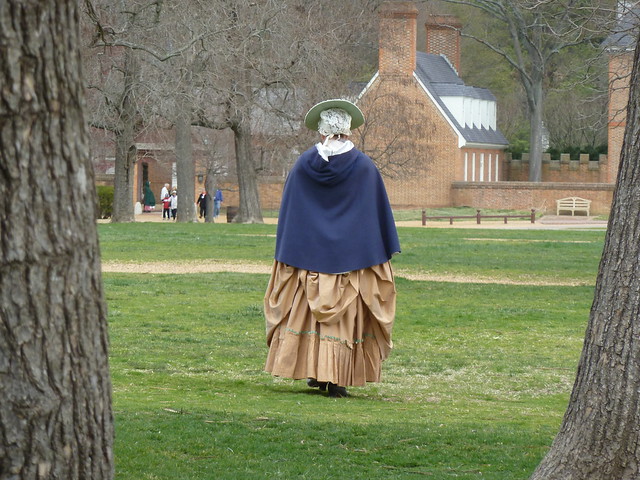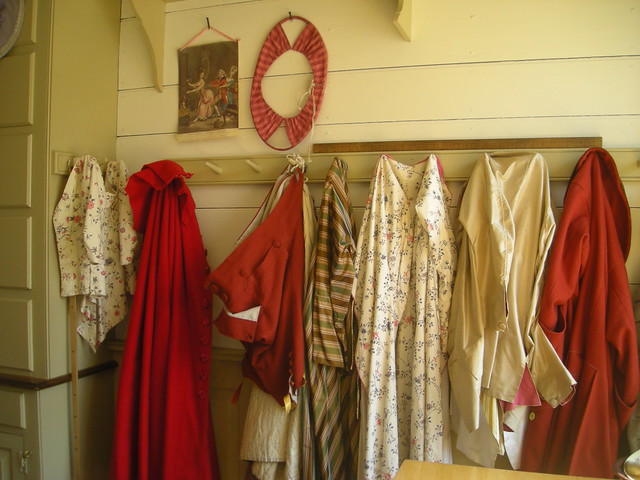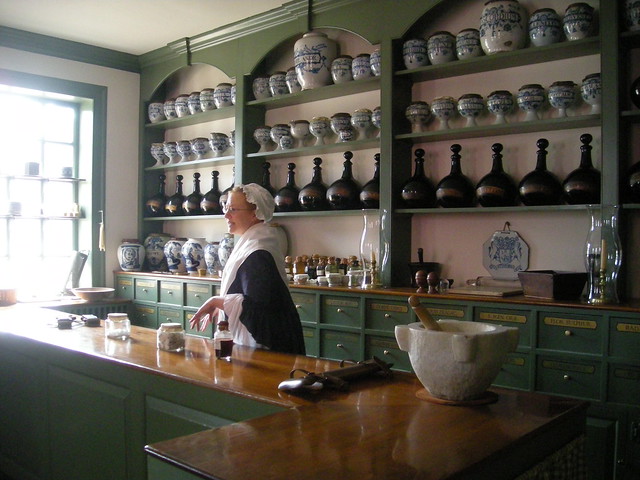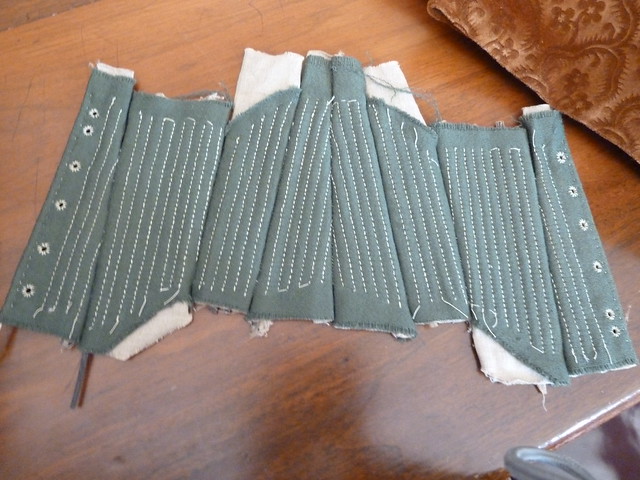Day Three
Goodies on display at the Margaret Hunter millinery shop.
My apologies for the absence of new posts Tuesday and Wednesday; Ashley and I ended our Tuesday evening with some English country dancing at Newport House and got back so late that I just dropped into bed exhausted (but happy!). Yesterday I was in bed by 9:30 after a day of pretties information overload. As a result, I'll be doing two postings this evening, so be sure to scroll up or down to make sure you don't miss one or the other of them!
Tuesday's lectures opened with a prodigiously enlightening discussion of "traditions and revolutions" in hairstyles and wigs from 1748-1804. Anne Bissionnette, assistant professor of material culture and curatorship at the University of Alberta, suggested that philosophy and history combined in hair at the middle of the eighteenth century, with styles reflecting the trend for recovered ancient cultures and aesthetics. In general, then, women's wig styles from 1748-1760 favored tight curls worn close to the head. By the 1760s, wigs were quite affordable and widely worn by all who could afford one. Bissionnette theorizes that this prompted a brief return to natural hair by the young gentlemen of the aristocracy in an effort to counter the equality of appearance across all social levels that inexpensive wigs allowed.
After a brief summary of the Macaroni movement of the 1760s and early '70s, the discussion turned again to women's hairstyles, which changed rapidly from egg-shaped to an inverted pyramid (again inspired by ancient examples) to the poof and hedgehog styles that dominated the 1780s. This turn towards informality and a (cultivated) "natural" appearance continued with slight variations into the turn of the century, corresponding to (or reflecting), Bissionnette argues, an increased emphasis on the individual. This lecture was so jam-packed with information that it's very difficult to try to summarize my pages and pages of notes into such a small space, so pray forgive me if I've omitted something. I assure you it was by necessity and not neglect! If there's anything you're interested in hearing about, just let me know and I can go back to my notes for more.

A CW interpreter on Palace Green.
Robin Kipps, the apothecary supervisor at CW, followed with a fascinating look at what might be called medical prescriptions for clothing in the eighteenth century. Scattered throughout medical manuals, she observed, are suggestions about quilting medicines into waistcoats or night caps (depending, of course, on the location of the malady), advertisements for specially-purposed health-related garments (cork jacket, anyone?), and even advice for parents on the proper use and function of leading strings (yeah, maybe swinging your toddler by them isn't such a good idea after all...). Her unique perspective on clothing and accessories suggested a fresh and fascinating new way to look at traditional fashionable items that could be re-purposed to serve highly specific functions.
The Pasteur and Galt Apothecary at Colonial Williamsburg -
an most unexpected place to find advice on accessories
(albeit it medicinal ones!).
After lunch, Susan North returned to the podium to reconvene with a talk about linen, cleanliness, and the fashion, form, and function of the white laundered accessory. Her lecture drew upon her current research project and offered a series of observations and questions prompted by the materials she has thus far encountered. The pristine white of kerchiefs, caps, cuffs, and ruffles served as an outward manifestation of cleanliness in underwear, North argued. Medical literature yields contradictions at every turn regarding the preference for and benefits of linen vs. flannel underwear, and civility literature often suggests that clean linen needed to clean more for fashion's and appearance's sake than for the sake of cleanliness. I'm always intrigued to hear about peoples' current projects, so I'll be eagerly anticipating further results as this one continues to develop.
A satin-striped silk gauze cap on display in the milliner's shop.
The final lecture, given by Cynthia Cooper (head of research and collections and curator of costume and textiles at the McCord Museum), took a tour through the changes in fashion of three prominent accessories: shawls, sashes, and scarves. Accompanying the talk (which spanned the early eighteenth century all the way to the end of the nineteenth) was a collection of stunning slides of items held in the McCord Museum and scores of illustrative prints and paintings. I found her focus on the "otherness" of these items of dress to be particularly illuminating. Shawls, for instance, arrived in Europe and England from India in the late 1790s. While images of them display a certain willingness to incorporate such an exotic item into fashionable continental dress, contemporary images simultaneously reveal an ambiguous relationship to it; while the shawl was a masculine article of clothing in India, Europe's aesthetic reaction to it, removed from its original function, re-imagined the shawl into a feminine accessory worn in a completely different way. There were scores of additional examples, but again, the limits of space prevent me from being able to include everything here! Again, just let me know if there's anything you were looking to hear about that I've left out and I'll happily post more. :-)
The formal part of the conference concluded yesterday with a jaw-dropping, show-stopping fashion show featuring the reproduction costumes and accessories of the Colonial Williamsburg milliners and tailors. Janea Whitacre, mistress of the trades of millinery and mantua-making at CW, narrated the development of the professions from the time of Elizabeth I to the invention of the sewing machine. As she shared amusing period anecdotes and historical tidbits related to the evolution and eventual divergence of the trades, costumed "characters" walked the stage, sometimes pausing to recite a piece, act a dramatic scene, or even sing a song of fashion for the audience (yes, certain accessories deserve to be immortalized in song, and the calash is definitely one of them!). The sheer number of gowns, cloaks, hats, mitts, caps, neckerchiefs, and shoes on display was incredible, each one more beautiful than the last. Oh what a dream job those milliners have here! If you'd like to see some photos from the fashion show, check out the facebook page of the Margaret Hunter Shop.
Reproduction unfinished child's stays.
PS: Just in case you're wondering where all the pretty pictures are here and on other blogs, photography during the conference is strictly on a private-for-personal-research-use-only policy, so to respect that, all of the photos in our conference posts are drawn from various other sites around Colonial Williamsburg, and not from the symposium itself.





3 comments:
Thank you thank you thank you for posting these! They've reinvigorated my passion for the history and psychology of clothing! It's so easy to get discouraged what with everyone and his or her dog being a "expert" just because they have an internet connection; what a lovely feeling to know that I can still do this and that there is still so much to learn! I feel so much better about my decision to continue to pursue this interest that started for me over two decades ago.
You're most welcome, Heidi! I'm so glad you enjoyed the summaries. This week has definitely been an inspiring one, between hearing all of these fantastic talks and meeting some pretty incredible and passionately dedicated people determined to keep raising the bar with their amazing scholarship. The academic side of the field is very much alive and well and thriving; the conference was completely sold out, and we learned that there are a handful of pretty incredible costume history books on the horizon! Huzzah!
Wow, that's a lot of information in one day! No wonder you were so tired! My son was just talking to George Washington about wigs the other day! How I wish I could have seen that fashion show! The milliner kept telling me about all the fun skits and songs she was going to throw in. Fun, fun, fun!
Laurie
Post a Comment